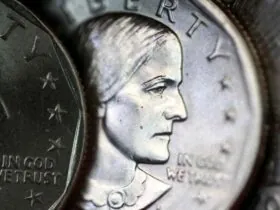While most quarters are worth their face value, some have hidden qualities that make them highly sought after by collectors. Among these, certain 25-cent coins from 2004 stand out due to a unique production error, making them worth thousands of dollars. One of the most notable examples is the Wisconsin state quarter, which, in certain instances, could be worth up to $2,000. Here’s how to identify these rare coins and understand what makes them so valuable.
What Makes the 2004 Wisconsin Quarter Special?
This Article Includes [hide]
The 2004 Wisconsin state quarter features a design with several distinct elements: a cow, a wheel of cheese, and an ear of corn. However, a subtle but crucial detail differentiates some of these quarters from others. Under one of the leaves on the corn cob, an additional leaf was mistakenly included during production. This error is referred to as the “extra leaf high,” and it drastically increases the coin’s value.
Look for the extra leaf on your Wisconsin state quarters! pic.twitter.com/0Qg2Dc3Tol
— Couch Collectibles (@couchcollect) May 26, 2022
The Value of the “Extra Leaf High” Quarter
Typically, the Wisconsin state quarter is worth just 25 cents, but those with the “extra leaf high” error can fetch significantly more. The Professional Coin Grading Service (PCGS) notes that the highest sale of a quarter with this error reached a stunning $2,530. However, the actual value of a coin can vary widely based on several factors.
Factors Affecting the Value of the Coin
The worth of a coin is not determined by the error alone. Several key factors contribute to a coin’s final market value:
- Rarity: The fewer the number of coins with the “extra leaf high” error, the higher the demand, making it more valuable.
- Condition and Grade: Coins in excellent condition—free of scratches, wear, or tarnishing—are worth much more than those in poor condition. A coin’s grade, which ranges from “good” to “mint state,” plays a crucial role in its value.
- Market Conditions: The demand for rare coins fluctuates. The popularity of the error coin may increase or decrease depending on the market trends, collector interest, and economic factors.
Understanding Different Coin Values
When evaluating coins, there are several terms used to describe their value:
- Catalog Value: This is the average price listed in coin catalogs or references, representing what most dealers will sell the coin for.
- Purchase Price: This is the amount a merchant is willing to pay for a coin or note, usually lower than the retail value.
- Retail Value: This is the price a dealer is likely to sell a coin for, typically higher than the purchase price.
- Wholesale Value: This is the price dealers charge when trading coins with each other, often lower than the retail price.
How to Determine the Value of Your Coin
To determine if you have a valuable 2004 Wisconsin “extra leaf high” quarter, consider these factors:
- Inspect the Design: Look closely at the corn cob on the quarter. If you spot an extra leaf beneath one of the leaves, you might have a valuable error coin.
- Check the Condition: Coins in near-mint or mint condition are worth significantly more. Look for signs of wear or scratches that could lower its value.
- Consult a Professional: If you suspect you have a valuable coin, it’s a good idea to have it professionally graded by an expert like the Professional Coin Grading Service (PCGS).
Conclusion
While the 2004 Wisconsin state quarter is typically worth only a quarter, the “extra leaf high” variety could be worth much more, potentially thousands of dollars. To determine if your coin is one of these rare finds, carefully inspect it for the unique extra leaf, consider its condition, and seek expert grading if necessary. With the right factors in place, your 25-cent coin might turn into a valuable collector’s item.







Leave a Reply